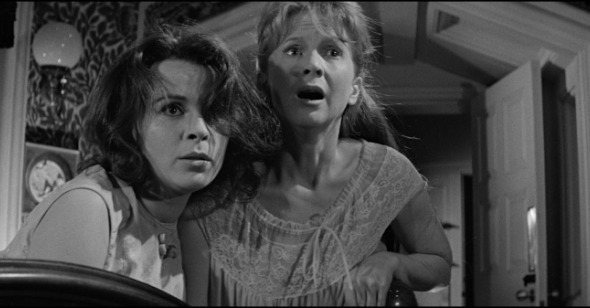Every Halloween, Reverse Shot presents a week’s worth of perfect holiday recommendations. Read past incarnations in our series “A Few Great Pumpkins.”
First Night:
The Haunting
In the past, I have always looked forward to composing my annual “first night” column of this week-long Halloween series of essays. My custom is that I try and write them during the loneliest hour of the autumn day, at the first hint of sundown—which this time of year always arrives earlier than I expect—when being inside with one’s thoughts and words feels unbearably intimate. Perhaps it’s because this year marks Reverse Shot’s twentieth anniversary and I have, of late, been feeling the weight of years—or perhaps it’s, unavoidably, the state of the world—but as I write this 18th introduction to this column, a certain solemnity is outweighing any ghoulish fun I prefer to associate with the occasion.
Since aging is one of the great human fears, it would make sense that the things that scare you change as you get older. In some ways, this is obvious, as almost all scary stories and horror movies are united in their exploitation of the very human discomfort with the great unknown and our refusal to confront our own mortality. Life feels only more precious as it withers, and our loved ones grow ever dearer to us as we combat the demons of loneliness that threaten to steal us away from them. So, for this year’s first entry, I’ve selected a movie that has changed for me as I’ve aged and which I’ve only recently begun to see as the terrifying film that the youthful version of me could never quite understand.
To be fair, I think my response today to Robert Wise’s The Haunting is just as much a reaction to the 1963 film’s hallowed source material, Shirley Jackson’s 1959 novel The Haunting of Hill House. I hadn’t read Jackson’s book (which she wrote in her early forties) until I was nearing 40, though I had first seen Wise’s film as a child, probably at 11 or 12. Already a horror junkie, with an intense adoration for Poltergeist and harboring a Stephen King obsession predictable for a New England kid growing up in the eighties, I found The Haunting to be a confoundingly cerebral affair—a bit depressing and too keyed into psychological terror for any of its external frights to make much sense. Where were the skeletons bubbling up from the swimming pool or the inanimate objects come to evil life? Instead, The Haunting gave me insinuations of ghosts, off-screen sounds, internal torments, psychological uncertainty—in short, the stuff that a young person, who has yet to understand that what’s inside is often much scarier than what’s out there, finds confounding or, worse, a cop-out. Reading Jackson’s book with middle-age on the horizon, I found myself swept up in the terror of its dynamic central concept: that the lonely, schoolmarmish Eleanor Vance’s doomed weekend stay at the infamous, haunted Hill House is not a journey to the unknown but something far scarier—a homecoming.
Jackson’s short stories are the summit of their form, with 1950's “The Summer People” standing, in my opinion, as one of the scariest of all works of fiction—and one of the few explicitly about the fears of aging. While I prefer her in that mode of terrible brevity, when she gives herself just enough space to hoist the rope and leave the reader desperately hanging, The Haunting of Hill House is a novel of such rich ambiguities and evocative images that it must stand with her best work. In it, she accomplishes the difficult evocation of the true uncanny. In an early scene, Eleanor looks around her designated bedroom at Hill House and notices its “unbelievably faulty design which left it chillingly wrong in all dimensions, so that the walls seemed always in one direction a fraction longer than the eye could endure, and in another direction a fraction less than the barest tolerable length.” Such a passage exemplifies the kind of barely perceptible horror that Jackson was so nimble at expressing, yet it also represents the kind of horror writing that could never be translated to cinema in any way—even in voiceover, which would only lay bare the insufficiency of the form to visually approximate this idea.
In many ways, Wise’s film is unable to capture the book’s odd dark magic, too often replacing it with an insistent Grand Guignol of crashing sounds, TV-melodrama score, expository narration, canted frames, and overly impassioned acting. At the same time, this all contributes to the sense of a film constantly on an emotional precipice, that it could crumble at any moment not because of the ostensible ghosts who walk the halls of Hill House but the fragile humans who've come to confront them. A disparate group of strangers who have had past supernatural occurrences have been invited to assist paranormal investigator Mr. Markway (Richard Johnson) in his attempts to locate the source of the Massachusetts mansion’s legendary disturbances; these include Claire Bloom’s vivacious yet secretive Theo and Russ Tamblyn’s wisecracking Luke, yet Julie Harris’s Eleanor, tired of living under the thumb of her domineering family and years spent taking care of a sick mother, has arrived with a seriousness of intent and sorrow of bearing that indicates there’s something different about her.
The nature of Eleanor’s difference is more central to the idea of The Haunting than the house’s myriad cold spots and bumps in the night, or rather they’re completely interlaced so one cannot discern a difference between human interior and architectural exterior. “It wants you, Nell,” says the ESP-gifted Theo to Eleanor upon their first tour. “The house is calling you.” But what else is calling Eleanor? Wise’s film extrapolates and enhances Jackson’s inference of Theo’s lesbianism, daring for the Production Code era, even following the 1961 amendment that allowed for the depiction of “sex perversion.” Bloom’s performance is entirely sympathetic and rather poignant in her stoicism, yet Theo is clearly an imp of the perverse: decadent, sensual, unashamed. “We’re going to be great friends, Theo,” says Eleanor. “Like sisters,” Theo responds with withering irony. Eleanor might want to be more than friends with Theo, yet she, like the film, is unwilling to admit it. Instead, The Haunting finds numerous ways of detailing the two women’s growing intimacy, bred in fear. This is depicted most memorably during the film’s centerpiece sequence, as the two women clutch each other in bed in an expression of menace worthy of the Gish sisters while the house’s crashing noises draw closer and closer with unbearable fury. We—and they—don’t see anything, and the film scrupulously maintains its rigorous commitment to telling (and listening) rather than showing—save the surreal image of the parlor’s massive door pushing inward as though a living, breathing organism heaving a sigh.
Even scarier, however, for the way it expresses how the house’s night terrors are hard to separate from Eleanor’s panic around her intimacy with Theo, is a later sequence in which the two women are again sleeping in the same room. By this point, Eleanor is being driven closer to madness and is being plagued by barely intelligible whispers and giggles, which seem to be drifting through from the next room or somewhere deep in the house's bowels. Wise depicts her agonizing fear by fixing the camera on a section of the wall, dimly illuminated by moonlight, where an abstract corner of the ornate, curving moldings looks almost like a face, out of which taunting, childlike laughter appears to emanate. Terrified, Eleanor reaches out and grabs Theo’s hand for comfort, squeezing it until the terrible moment passes. Only at the end of the scene, when Eleanor has nearly gone mad with anxiety and the lights come on does she realize that Theo has been across the room in a different bed. She’s been holding someone (or something) else’s hand the whole time. It’s a scare that can be communicated more effectively in writing—the idea comes directly from Jackson’s book—and thus the film relies on voiceover to get it across (“God, God—whose hand was I holding?”), yet the horror feels even more acute in the film, considering the explicit way it deals with Eleanor’s fear of Theo’s sexuality. Later, Eleanor will lash out at Theo, referring to “unnatural things…nature’s mistakes—you, for instance!” Theo crumples at the accusation, aware that she’s referring to something more than her extrasensory perception, though in Jackson’s world all aberrant things are equally fascinating and worthy of inquiry.
Wise got his earliest directing jobs for Val Lewton’s legendary cycle of B-horror movies for RKO in the forties (including the superlative Curse of the Cat People and The Body Snatcher), and The Haunting is at its best when it evokes those films’ unparalleled deployment of quiet, lurking shadows and faces frozen in unspeakable terror. If the later film doesn’t reach the heights—or, I should say, depths—of those pitch-black horror benchmarks, it remains similarly committed to leaving its hideous terrors off-screen. Like the nihilist Jacqueline in Lewton’s The Seventh Victim, Eleanor seems motivated by personal demons for which any explanation would seem inadequate. Eleanor’s drive towards death, back to the house that means to claim her body and soul, could never have appealed to me as a child because I hadn’t yet understood the character’s peculiar, aching fragility. Nor could I have appreciated Harris’s exquisite embodiment of what it means to be terribly lonely. It’s to the film’s credit that even though I’ve seen it many times now, I still can’t quite grasp Eleanor—who she is or what drives her to the grave. Maybe in another ten years I’ll get closer to an answer. —Michael Koresky
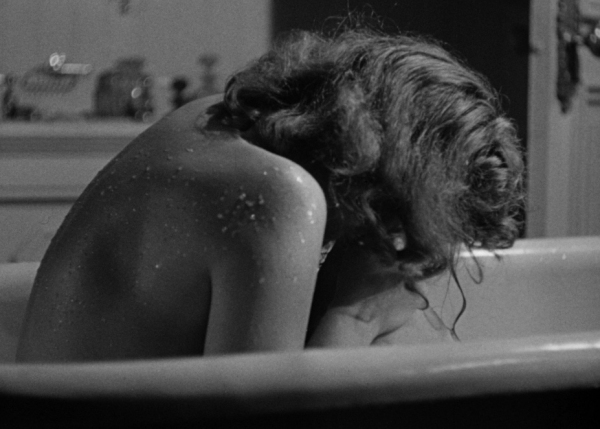
Second Night:
Cat People
In many of the best horror films, such as The Texas Chainsaw Massacre or Suspiria, the characters are reacting to the film’s surrounding aesthetic, but in Cat People the aesthetic stems from the neurosis of its main character. Irena Dubrovna (Simone Simon) likes the darkness. She claims that it’s friendly. Cinematographer Nicholas Musuraca paints Irena’s environment with enveloping shadows and plunges the world around her into an eternal dusk, evoking how her perception of herself becomes increasingly catastrophic as her marriage to Oliver (Kent Smith) falls apart. Irena believes that she is the victim of an ancestral curse that transforms her into a black panther when she becomes sexually aroused, and she has not consummated her marriage due to this fear. She has become comfortable isolating herself, but she longs to cast off her loneliness and trade it for the life of a “normal” woman.
Cat People was the first of Val Lewton’s B cycle of Horror pictures at RKO. These films were quiet, morose, and poetic in how they attempted to demystify and understand darkness. Lewton’s characters had a morbid curiosity of death and walked towards horror, rather than flee from it. Jacques Tourneur, now free from MGM, was at home crafting these tales of the macabre, and his patience as a director brought forth an emotional potency that gelled perfectly with the psychological dimensions of the characters.
There are crosses scattered about the visual landscape of Cat People, and suggestions of an ungodly moral rot, which casts Irena as someone who is perceived as obscene due to the nature of her sexual idiosyncrasy. This element of monstrosity, in conflict with Christian values, has rendered much of the early horror canon as queer-adjacent. Irena is among these characters, but unlike Frankenstein’s monster or Charles Laughton’s Hunchback of Notre Dame, her monstrosity isn’t immediately visible. Irena’s problems are connected to being found out and how that would change others’ perception of her. Her wounds are self-inflicted, and the aesthetic of Cat People is in complete synchronization of this idea, making it one of the earliest examples of horror as an empathetic device. Cat People remains unusual because its horror is not primarily about crafting a scenario of terror to be startled by, but rather it forces the audience to fester in Irena’s discomfort with being a monster.
Tourneur crafts numerous extended sequences of isolation and intimacy that emphasize audience identification with Irena. Because of this, Cat People contains a palpable loneliness that’s hard to shake off. Her persistent feelings of separation from modern society make those scenes of quiet torment all the more harrowing. Chief among them is one where Irena merely sits in a bathtub with her shoulders hunched as she weeps. This is a rare image from this era of horror: it is helpless, and the tragedy feels inevitable, but it is also not a conclusive moment in which we are made to empathize with the monster only through death, as in Frankenstein. In this scene, Irena’s body is visible—she is usually costumed in heavy, black overcoats—and we can see that there’s nothing strange about the way she looks. She’s a woman who has been made to feel that she is different from other women, and her monstrous qualities reflect her feelings of ostracization.
Cat People is a horror film of sorrow, and it foreshadows the genre’s modern fascination with character psychology. Irena contains numerous queer metaphorical readings. When Oliver takes an interest in his coworker Alice (Jane Randolph), Irena grows jealous; his choice to pursue a woman who is unlike Irena forces her to believe every horrible thing she assumes about herself, and only makes her differences more resonant. Screenwriter DeWitt Bodeen was a closeted gay man when he wrote the screenplay for Cat People, (he began living with actor Val Dufour in the 1950s), and the anxiety of a “forbidden” sexual response drives much of Irena’s frustrations. Cat People has since taken on a second queer reading through Irena’s fear of transformation with its parallels to gender dysphoria. The destabilization of the body as it becomes something unwanted is on the surface of Irena’s anxiety, but it is her coveting of what other women have that makes her a character of trans feminine interest. When Oliver sends Irena to a therapist, she claims that it is not her mind that is troubled, but her soul, which suggests something instinctual and immutable about herself. When Irena’s neurosis culminates in a transformation, the lighting dims into complete shadow, and Irena is then only seen in silhouette. Confronted by the monster that Irena has become, Oliver and Alice grab an object of Christian faith—a crucifix—in order to repel her. The placement of the crucifix as a weapon in horror films is usually conceived to ward off demons or the eternal pall of death, but here, perhaps for the first time, it’s used against someone we’ve gotten to know as a person, and whose psychology is front and center.
In Kier-La Janisse’s memoir of horror film criticism House of Psychotic Women, she argued that the best horror films were not those that were actually scary but those that were tragic. Cat People has scenes that are indeed scary—such as Irena’s stalking of Alice in the dead of night, which culminates in the invention of the jump scare, when a howling bus arrives in the nick of time; or when Alice sees a panther in the rippling shadows of an indoor community pool. These scenes are clever and momentarily startling, but rather than engage with Alice’s psychology, the identification of the audience is in these moments reversed. Tourneur and Lewton knew the emotional core of the film was with Irena. It’s why this film is entombed in darkness. Cat People is a film of shadows, because they’re all Irena knows. —Willow Maclay
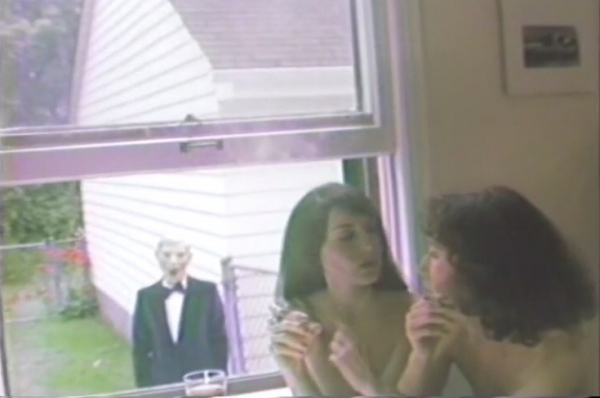
Third Night:
Possibly in Michigan
In the American suburbs, the local news provides its own kind of horror programming. Amid convenience-store car crashes and small-town squabbles, there are frighteningly regular accounts of domestic violence and abuse. Every so often, you’ll hear of a grisly, perverse murder taking place a five-minute drive away from your house.
Throughout her 40-year career, the Milwaukee-based video artist Cecelia Condit has drawn on such real-world stories of brutality against women; grotesquerie is always proximate. The narrator of her debut short, 1981’s Beneath the Skin, recounts discovering that her boyfriend had killed his prior girlfriend and was concealing her corpse in his closet—a tale taken directly from Condit’s own life after she dated Ira Einhorn, the Unicorn Killer. Her best-known short, 1983’s Possibly in Michigan, transforms similarly disturbing source material—it’s based on various friends’ experiences with assault—into a dark nursery rhyme: a Casio opera set in perverted suburbia.
A peppy narrator fills in the basics of the story: as best friends Sharon (Jill Sands) and Janice (Karen Skladany) browse an eerily empty shopping mall, they’re pursued by a creepy, open-mouthed fellow named Arthur (Bill Blume, though occasionally a masked Condit), who’s described at various points as a “prince charming,” though he has a predilection for cannibalizing his girlfriends. The film’s impact is centered in its music, composed by Skladany: almost all the dialogue is sung with a schoolyard lilt, like possessed Victorian children performing Brecht. As Sharon and Janice spritz fragrances at the mall’s perfume counter, they reminisce about a relative who put her poodle in the microwave oven, wanting to “dry” the dog off, but killing the animal and herself in the process (also ripped from the real-world headlines). Arthur looms in the background as a threat to both women, mimicking their choreography, but he’s just one part of their freaky milieu. After all, this is their choice of idle perfume chatter, sliding chirpily up and down the scales: “To eat it?! / No no no no no no no no, silly! / To dry it!!!”
Macabre as all this is, the music is defiantly, discordantly giddy—but never ironically so. It’s as though the duo’s song is attempting to drown Arthur out, overpowering the real-world kernel of violence that he represents. This is part of Condit’s agenda as a horror filmmaker; she’s out for revenge, and she wants it to be total. As a vengeance film, Possibly in Michigan’s investigation of gendered violence contrasts productively with the early-’80s boom of slasher films. Consider Amy Holden Jones’s Slumber Party Massacre (1982), among the most self-reflexive from this wave: Jones’s film plays with sexist genre tropes in a major key—right down to the overt symbolism of the phallic weapon—but still operates within the constraints of the genre. Condit’s idiosyncratic style allows Possibly in Michigan to break free from familiar scripts; as it hurtles toward Arthur’s comeuppance, it’s a more expansive, atmospheric exploration of feminist agency. She’s always frank about sexual violence: when Arthur breaks into Sharon’s house and beats her to the ground, the visuals become noticeably choppier, degraded; this passage is not gory like a slasher movie, but evokes a more brutal transgression, like vague snatches of a snuff film bootlegged off a TV set. When Sharon and Janice have their revenge, their song returns, as though they’re writing a new melody to inhabit together.
Possibly in Michigan resurfaced on the stranger corners of Reddit in the 2010s and has enjoyed a recent revival on TikTok. In part, this longevity speaks to the off-kilter delight of the music—if you’re trying to make your high-school friends laugh, the poodle discussion is a good choice of a 15-second, decontextualized clip to lip sync to. But Michigan’s staying power likely owes just as much to the fact that it genuinely feels like something you could make in your house after school, armed with a commitment to the right vision. It’s filmed in backyards and dim kitchens; household dogs chomp on bits of steak for B-roll. Arthur’s mask also looks like the kind of cursed object you could unearth at a neglected five-and-dime store—though Condit actually found this monstrosity, a redheaded face with a gaping maw, at a dentist’s office. Condit renders these environments even stranger in montages; her quick cuts and eerie, subliminal dissolves transfigure a generic world into a half-remembered nightmare.
Skladany’s theme song for the film, “Animal Cannibal,” is a gleeful lo-fi anthem: “I bite at the hand that feeds me / Slap at the face that eats me.” Some of Condit’s students at the University of Wisconsin-Milwaukee would sing such melodies in the hallways, willing partners in crime. It’s these lyrics that root the film in its eponymous location, “possibly in Michigan”—somewhere in the dark heart of America, anywhere and nowhere, but always closer than you think. —Chloe Lizotte
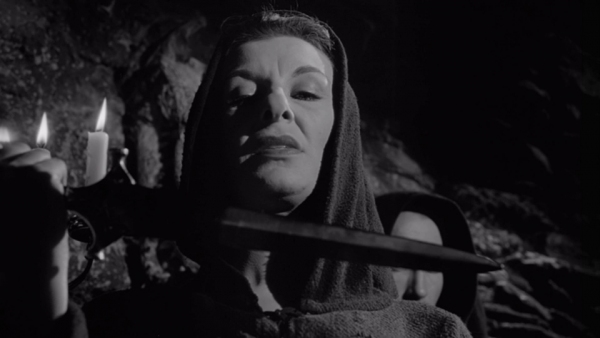
Fourth Night:
The City of the Dead (aka Horror Hotel)
The City of the Dead (or Horror Hotel, to use its alliterative American title, which might have suggested that it was a comedy, or even a musical?) is a downright peculiar, 76-minute-long micro-budgeted British studio chiller from 1960 about witches, set in modern New England and featuring a mostly British cast essaying American accents.
The most accurate of these—although certainly not the most immediately convincing—is probably the one deployed by its lead actor, Christopher Lee, who injects a dose of Cornish into his strident East coast drawl, which corresponds to how a Massachusetts accent might have sounded in the 17th century (Arthur Miller’s The Crucible was less than a decade old at the time of filming). Lee had by that time already been Dracula (and before that, the Creature in Frankenstein) for Hammer Films and is a formidable visual and aural presence. His appearance at the outset of City of the Dead, as a rather too intense professor of witchcraft and demonology given to gnomic pronouncements like “the basis of fairy tales is reality…the basis of reality is fairy tales,” feels, in keeping with so much else in the opening half of the film, standard: a paycheck cameo. One of his students, Nan (Venetia Stevenson), is inspired by Lee’s exuberance to visit the town (it really doesn’t feel like a city) of Whitewood, Massachusetts, alone, to discover for herself more about its connection to the occult and what truth might lie in the stories Lee has told her. On Nan’s arrival, the place is covered in a low layer of fog. (We can only presume that a soundstage in Shepperton studios brimming with dry ice will have slashed the film’s production design budget.) She meets a gas station attendant who warns her off, then a mysterious man hitches a lift with her. Finally, she is greeted by the menacing presence of Patricia Jessel, playing a haughty hotel landlady with a remarkable resemblance to the notorious witch Elizabeth Selwyn, whom we have seen cackling at the stake during the film’s opening flashback.
Why am I being so flippant about all of this? Largely because during the first half of the film, the spectator is entitled to settle into an attitude of puzzled familiarity. Beyond some striking monochrome photography, Jessel’s memorable face, and a somewhat jarring scene of Stevenson in some decidedly chic underwear, there is little that doesn’t appear cozily predictable and almost too obvious. But even more so because, at the film’s precise midpoint there is a plot development, accompanied by an outrageous, shocking match-cut, that throws the film off its axis almost completely. The filmmakers, in their insistence up to that moment on the perfunctory and the frankly clichéd, have set the audience up to expect a prosaic, comfortable horror experience, which it then forbids them. This pivotal halfway moment, which evokes a certain Hitchcock film made in the same year to much greater acclaim, changes all of that for good. It injects into City of the Dead a sudden, horribly violent burst of modernity and grim humor which immediately compels us to think differently about the characters, the film we are watching, and—one imagines, for contemporary audiences—the horror genre itself.
It’s a confrontation, mirroring the film’s plot, between ancient and new. It’s also a statement, and in a sense a dirty trick, but a devilishly good one too. Nothing that follows this sequence feels the same as before, nor can it really be so. Every subsequent image, which might have looked staid or studio-bound, has now been contaminated with something resembling realism and impregnated with the dread that accompanies unpredictability. It’s almost like a bond of trust has been broken between the filmmakers and the audience and replaced by a gloriously assaultive atmosphere of threat.
In this second half, the daughter of the local priest takes up the investigation into the activities of a full-blown coven of witches operating in Whitewood. She is assisted by the brother of one of their victims. As the coven gets closer to being exposed, two truly gruesome murders are perpetrated, including one—almost unwatchable—on an innocent mute girl who is trying to alert the investigators by writing on a pad of paper before she is apprehended and strangled.
Inescapable are the moments that resemble later horror masterpieces. The dark corner of the hotel lobby, lingered upon three times, insinuates a lurking presence that a modern audience might anticipate, like Michael in Halloween. The door to the coven’s hall doesn’t simply creak closed portentously behind the witches’ sacrificial victim as she is carried to her doom—it slides shut, vigorously and quickly, which evoked for me the horrifying metal butcher’s door framing Leatherface’s first appearance in The Texas Chainsaw Massacre. At one moment Stevenson finds herself in a bookshop, face-to-face with a beautiful brunette woman (Betta St John); she exudes a combination of guardedness and comfort, in a scene that is warmly lit—a respite from the shroud of anxiety which envelops everything up to that point—and presented with an uncanny similarity to the corresponding “relief” sequence between Tippi Hedren and Suzanne Pleshette in The Birds. Even the protagonist’s name, “Mr. Barlow,” keeps being repeated, as if the film were in dialogue with later classics, such as Salem’s Lot. This film’s open influence on numerous heavy metal bands like Iron Maiden—as well as The Love Witch director Anna Biller and, inevitably, Rob Zombie—suggests that despite its meager box office, City of the Dead may have been seen, and hard-felt, by many. The film even arguably gave birth to the Amicus production company (formed by producers Milton Subotsky and Max Rosenberg shortly after its release), which made its name on low-budget, anxiety-horror, throwing audiences off the predictable, while Hammer fed them more of it.
The last shot of City of the Dead will stay with all who see it. Completing the plot’s 300-year circle, it embodies a fantastical combination of beauty, melancholy, and utter repulsion that characterizes all great horror. —Julien Allen
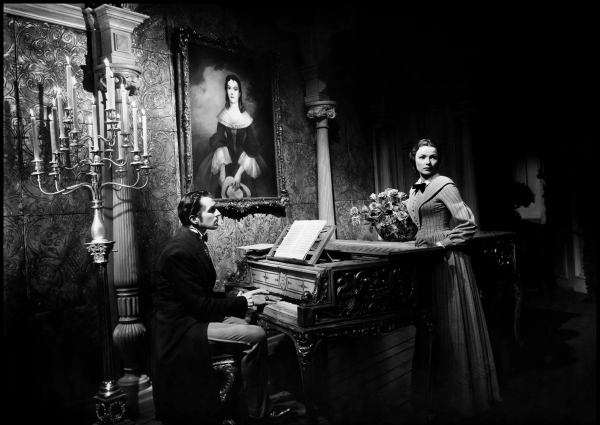
Fifth Night:
Dragonwyck
The lightweight Anya Seton period novel on which Joseph L. Mankiewicz’s 1946 directorial debut, Dragonwyck, is based, was published in 1944 while World War II was grinding on. Thus, both book and film’s somewhat sledgehammering anti-“foreign” and pro-“American Values” worldviews arrived within perfectly appropriate contexts. The film’s generic scary-movie plot particulars (haunted mansion, dark family secrets) are enlivened and lent geopolitical sass and color by its hilariously contemptuous portrayal of a dying ruling Europe and a fawning infatuation with its corny caricature of American virtues. So, while Dragonwyck might not be the most frightening Great Pumpkin, it warrants placement in the patch due to its fascinating propagandistic touches, elegant direction, and elevated performances.
Set in the idyllic Hudson Valley environs of 1844, Dragonwyck takes place in the context of the downfall of the patroon system, in which the Dutch West India Company, starting in the early 17th century, granted its settlers in the New World large deeded tracts of land on which they could lord over slaves and rent-paying farmers, and set up courts and other civic infrastructure. When the British took over, they allowed this rule-by-patroon to continue, but at the largest and most successful such patroonship, Rensselaerswyck, the lax, benevolent rule of the super-rich Stephen Van Rensselaer gave way to his sons’ greedier methods, leading to the Anti-Rent War and the end of the system. These patroon sons ruling over the last vestiges of state-sanctioned indentured farming in the region no doubt inspired the grotesquely elegant character of Nicholas van Ryn (Vincent Price), the prissy overseer of the old Dragonwyck farm and estate who, at rent-collecting time, sits on a garden throne declaring “The patroon is ready—come pay your tribute” and “Enjoy the privileges I allow you.”
Meanwhile, in Greenwich, Connecticut, the simple lives of independent farmer Ephraim (Walter Huston), wife Abigail (Anne Revere) and his two daughters (including Gene Tierney’s Miranda) are disrupted by a letter from van Ryn, who happens to be Abigail’s distant cousin, asking one of the daughters to come live at Dragonwyck, despite them never having met him. Twinkle-eyed Miranda, stifled by the pinched expectations of her small world and having read of the fantastic finery of titled aristocratic life, leaps at the opportunity against the severe protestations of her cranky, religious father. Huston is brilliant as the gruff Ephraim, dominating and hard-headed (“Everything is what no man should ever want”), whose stolid veneer cracks once he realizes his daughter’s stubbornness outweighs his. Accompanying her to “The City of New York” (the title cards match the film’s “prestige” desperation), Ephraim mugs with bewilderment at amenities like hotel luggage handlers, and Huston amusingly overacts as Ephraim squints and blinks at van Ryn’s description of patroonship, so alien to his self-made libertarian values (“I’d rather own one half-acre of dirt and rock than work another man’s land!”).
Van Ryn’s designs become immediately apparent during his and Miranda’s steamship jaunt up the river to Hudson, NY, as he remarks on her prettiness (a topic impossible to avoid when Tierney’s onscreen), and the rot beneath the fairy-tale facade shows as soon as we meet his rude wife Johanna stuffing herself at the dining table and demanding her husband assure her he brought “those wonderful New York pastries… did you bring the Napoleons, honey puffs and the mocha bon bons?” Johanna’s gluttony is clearly stifling deep unhappiness, which we learn involves their lack of a male child and which has some mystical connection to van Ryn’s great-grandmother, whose unsettling portrait hangs near a harpsichord that plays, at night, music only van Ryns (by blood) can hear.
Once van Ryn bumps off his wife with the help of a poisonous oleander-like plant, Miranda, whom he hopes can give him his sought-after heir, inevitably steps in after a tasteful Greenwich interlude. The film’s remainder sees the resentment of the serf farmers—allied with a blandsome young doctor with eyes for Miranda—boiling at the same time that Miranda grows ever more awakened to van Ryn’s Old World sickness and laudanum-addled mania, leading to a fatal showdown and climactic shout of, “That’s right—take your hats off in the presence of the patroon!”
Like Mankiewicz’s The Ghost and Mrs. Muir (1947, also with Tierney), Dragonwyck is disposable from a plotting perspective, ersatz-Brontë gothic pastiche. But both films’ ample pleasures lie in the particulars. In Muir, it’s Bernard Herrmann’s rich, poetic score (far superior to Alfred Newman’s obvious, hand-holding cues here), while Dragonwyck is lifted by the director’s seemingly inborn sense for strong compositions and graphic match cuts and its supporting players. Besides Huston there’s Spring Byington as loose-lipped maid Magda (“You mustn’t listen to me, Miss. No one ever does.”) and the severe Revere, a staunch Communist in real life whose Abigail is reminiscent of Agnes Moorehead in Citizen Kane, another rural mother who loses a kid to a swooping-in rich benefactor.
Still, the film’s tallests achievement are Price, predicting future lisping, imperious creeps in the Roger Corman Poe adaptations, Witchfinder General, and others, and the entire conception of the monstrous van Ryn, with his constant stream of delightful lines both pretentious (“Martin [President Van Buren] is an old friend and neighbor of mine”) and mean (“We don’t listen to servants or their superstitions”; to his wife: “Do you believe there is a god who spends all day snooping on human behavior? You sound like a child on your father’s knee”). After insulting Miranda’s disabled Irish friend and maid (a young Jessica Tandy) with “deformed bodies depress me … you loathsome little cripple,” van Ryn pivots jarringly to feigned sweetness, turning on his honeyed voice and gifting Miranda jewelry “from Mr. Tiffany’s new shop” (shades of Mr. Show’s “What’s wrong, a few too many of Mr. Graham’s crackers?”). Even as he mocks his farmers’ “prayer-fattened” notions of life, liberty, “and the pursuit of happiness or some such,” he remains, against all odds, a strangely pitiable and romantic figure. He embodies a relatable dissatisfaction with “ordinary” life, as he gazes on the stormy Catskills with his, dare I say, admirable wish: “not to be chained into a routine living that is the same with others, so long as there are those mountain tops and clouds and limitless space…”. —Justin Stewart
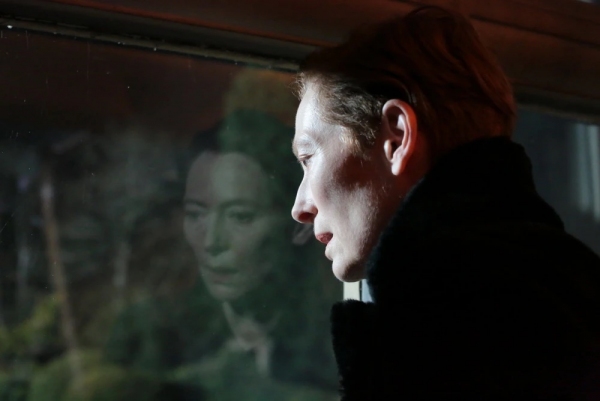
Sixth Night:
The Eternal Daughter
There’s really no point in arguing over whether Joanna Hogg’s The Eternal Daughter is a horror movie or not. With a film this elusive, atmospheric, and exquisitely uncanny, wielding generic qualifiers feels churlishly beside the point. It makes some kind of thematic sense that Hogg’s 2022 film came and went like a ghost last December, quietly dematerializing from theaters. There’s something about The Eternal Daughter that makes it seem like it didn’t quite happen at all: it’s almost too delicate and unbearably poignant to exist. It’s also scary in that way that purposely ambiguous films are rarely able to achieve but which classic short ghost story fiction writers like Edith Wharton, M.R. James, and Walter de la Mare captured so well. And while there’s ultimately nothing malevolent in Hogg’s pocket-size tale, there are profound depths to its essaying of psychological fears: of loss, of self-reckoning, of the undiscoverable country of the past, both personal and historical.
Set entirely at a nearly empty, fog-enshrouded, purportedly haunted country house hotel, The Eternal Daughter was filmed at the looming, ivy-entombed, 18th-century estate Soughton Hall in north Wales. As such it has the trappings of gothic cinema: inexplicable bump-in-the-night sounds, claustrophobic hallways, eerie light sources, mournful Bartók on the soundtrack. In one sense, that’s all they are—trappings: implying certain general parameters of what to expect and then leading you to wonder if you’ve been misled. Yet to think of Hogg’s outward genre elements as merely decorative is to fall into another trap: she’s not leading you away from horror. Rather, she’s gently, clammily holding your hand and guiding you right to the emotional essence of the ghost story. In the most literal way, the ghosts here are memories, which might seem an obvious manifestation, but Hogg knows there are few things scarier than a human daring to reckon with the ghosts of the unknown past and the demons of the unknowable future.
Middle-aged filmmaker Julie has brought her elderly mother Rosalind (both played mesmerizingly by Tilda Swinton) for a birthday weekend at the hotel, though she has an ulterior motive: Julie’s using this experience and their conversations as research fodder for an upcoming project, even occasionally recording their interactions surreptitiously on her iPhone. We come to discover that Julie hasn’t selected this mansion merely for its hospitality or reputation; rather it has familial significance—before it was converted into a hotel, this was the family estate of Rosalind’s relative, and she stayed here as a girl during the war. Julie hopes being there will jog happy reminiscences for her mother and instigate pleasant dialogues, yet something more rueful and melancholy results from this journey into the past, surfacing WWII-era traumas and painful family recollections. For Julie, a guilt-ridden workaholic who wants nothing more than to have created a warm bonding weekend with her mother, the true terror is that she may have set the stage for a trip down memory lane better not taken. Every creepy nuisance that the hotel offers also brings with it the specter of disappointment: rattles and eerie noises from the empty room above that make sleep for Julie impossible; Rosalind’s devoted Springer Spaniel going temporarily missing in the dead of night; an almost comically acidic receptionist who doubles as the restaurant’s sour waitress. It’s not the weekend Julie envisioned, but more perturbing, she comes to realize that she might know less about her mother than she thought.
Rarely does a ghost story feel as fragile as The Eternal Daughter, which is rather extraordinary considering that the form would seem to call for a gossamer touch. Despite its being so elemental in its use of classical horror details and designs, when first watching it, I felt as though I had never seen or felt anything like it. There are moments that undoubtedly recall earlier works (a ghostly face in the window feels right out of The Innocents or M. R. James’s story “Oh, Whistle and I’ll Come to You, My Lad”; Bartók’s “Andante Tranquillo” from “Music for Strings, Percussion, and Celesta” summons The Shining), yet there’s nothing referential about Hogg’s film. Her choice to emphasize the spooky stuff in what is ultimately a psychologically rattling drama about a daughter’s inability to connect with—and inability to see herself in—an aging mother she desperately wants to hold on to elucidates both the emotions of her story and an interpretation of horror’s meaning.
Just as there’s no gimmick to the uncanny double casting of the brilliant Swinton (she just is these women, and you forget you’re watching one actor mere minutes into the film), horror is not a device here—there’s nothing winking or clever about its deployment. Hogg’s cinema is always oblique; whether she’s dramatizing a relationship destroyed by addiction (The Souvenir), a marriage thwarted by professional and architectural spaces (Exhibition), or families riven by ferocious dysfunction (Archipelago, Unrelated), there are always lingering questions about what really happened—or rather, did we, as viewers, see or hear or perceive what the characters did? A truly haunted movie, The Eternal Daughter ends on a succession of ambiguous moments like these, inviting us into a space where time has broken down and nothing is fixed other than the inevitability of our own mortality. —Michael Koresky
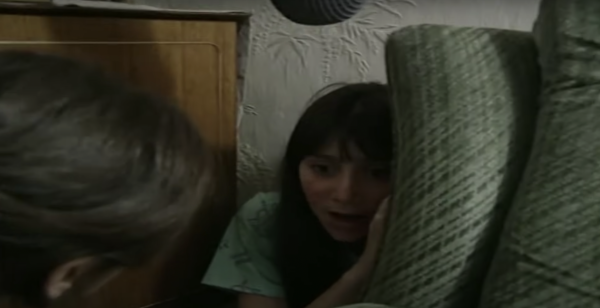
Seventh Night:
Ghostwatch
It’s a truism that the best pranks are in the worst taste; with this in mind, Steven Volk’s feature-length BBC presentation Ghostwatch is one of the great pranks in television history. Inspired equally by the po-faced BBC teleplays of Quatermass creator Nigel Kneale and the flamboyant scare tactics of Nicolas Roeg’s Don’t Look Now—and adding a healthy dollop of Orson Welles’s insidious medium-is-the-message showmanship, skillfully rejiggered for a paradigm-shifting era of television—Ghostwatch adopts the form of a live-to-air documentary focusing on a supposedly haunted house in West London.
Its host, Michael Parkinson (who passed away earlier this year), was an axiomatic presence in British prime-time programming, and as such lent the proceedings a necessary—and weaponized—air of gravitas. Over the course of 90 minutes, Parkinson and his various co-host and correspondents, including a reporter and camera crew embedded with the supposedly poltergeist-plagued Early family, descend from professionally jovial skepticism to full-fledged panic as the footage being beamed into the studio becomes more and more inexplicable. The legend goes that among the thousands (and thousands) of terrified callers flooding BBC switchboards on October 31, 1992, was Parkinson’s elderly mother, who genuinely feared for her son’s safety.
As an exercise in tricked-up horror storytelling, Ghostwatch has a lot to recommend it, starting with its state-of-the-art presentation: its array of motion-detectors, hidden microphones, and thermal-imaging cameras prefigure countless millennial ghoul-hunting programs, and the various video textures are wonderfully authentic—as are the cheesy, era-appropriate titles and graphics. The real ace up the film’s sleeve, though, is its implacable sense of patience. Not only does it take a while for the expertly ersatz proceedings to become interesting, but the boredom of the participants (Parkinson included and especially) is foregrounded to comic effect; the underlying—and, at first, mostly unspoken—feeling is that the Earlys, who comprise a mother (Brid Brennan) and two prepubescent daughters (Michelle and Cherise Wesson) are fraudsters who are both exploiting and being exploited by a national broadcaster looking to juice their Halloween night ratings.
The strenuous interplay of the hosts becomes a kind of psychodrama unto itself, pitched on a fault line between conviviality and contempt. The exception is in-house parapsychologist Dr. Pascoe (Gillian Bevan), who’s quicker than the others to buy into aspects of the Earlys’ story, and who keeps exhorting the editors and directors to pull up various pieces of videotape—including off-site interviews and archival materials in addition to live surveillance footage of the property’s various rooms and hallways— in order to piece together something like a coherent narrative.
Ultimately, the details of the supposed ghost’s backstory, involving a local urban legend about a cross-dressing child killer, are irrelevant, partly because Volk is so coy about showing us anything definitive—even in the home stretch—and partly because in this case, such lurid specifics only serve to dilute the otherwise pure sense of confusion and dread. If Ghostwatch suffers from clunky exposition, it’s still smart enough to have influenced the likes of The Blair Witch Project (1999) and Lake Mungo (2007), both of which borrow liberally from its scene-setting strategies; as for Paranormal Activity (2009), it’s fair to say whatever Oren Peli’s stated influences, he pretty much hijacked Volk’s time-coded home-video aesthetic, not to mention the eerie bit of sound mixing that underscores its scariest moment (you’ll know it when you hear it).
Viewed outside of its original and diabolically plausible context, Ghostwatch can’t help but feel a little dusty, but as an exploration of mass susceptibility to superstition that climaxes with the suggestion that something malign has been unleashed not only in the studio but the homes of viewers around the country (or the world), it functions nicely—and more than a bit unsettlingly—as an allegory of itself. —Adam Nayman
